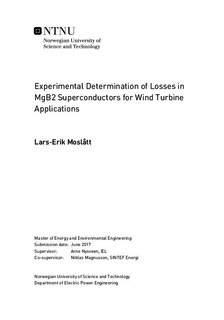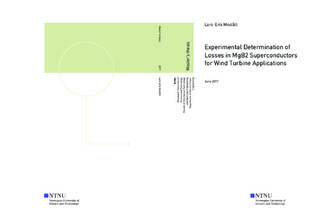| dc.description.abstract | Superconducting generator field windings are suggested for the next generation of wind turbines. The foreseen wind turbines with power ratings greater than 10 MW give raise to technical challenges. Superconducting field windings can produce strong magnetic fields with a compact design. Generators with field windings made of superconducting MgB2 wire could potentially reduce weight, material requirements, maintenance requirements and power losses, compared to conventional wind turbine generators.
Losses in the superconductors increase the cooling costs of the system, hence these losses affect the economic feasibility of applying superconductor technology for wind turbine applications. Superconductors in a rotor field winding will be exposed to a strong DC magnetic field with an AC magnetic field ripple. A theoretical model of the AC losses in the superconducting material MgB$_2$ predicts increasing losses when the strength of the DC and AC magnetic field increase. However, experimental testing is required to determine the magnitude of the losses in a MgB2 superconductor.
A superconductive MgB2 generator field winding demonstrator has been developed by SINTEF Energy Research in collaboration with NTNU, as part of the research project INNWIND.EU. The field winding is used to produce a strong background DC magnetic field during testing of AC losses. Custom hardware have been designed, produced and installed to produce a controlled AC field ripple and to measure the losses in a 10 cm sample of a MgB2 superconducting wire. The losses are measured using a calorimetric measurement method. The test equipment is installed in the air gap of the field winding, in the existing cryogenic cooling environment of the field winding. During testing, the field winding and the wire sample is cooled to temperatures of about 20 K.
Losses are measured for different AC magnetic fields up to 21 mT peak, with different background DC fields up to 0.35 T. The losses measured increase with the 2nd power of the AC magnetic field, regardless of the strength of the background field applied. For a fixed AC field with different background fields, the AC losses peak at about 0.1 T DC field and are lowest at the highest field value of 0.35 T. After the first strong magnetization of the wire sample, it was found a significant difference in the AC losses as a function of the DC background field. Considering the magnitude and the loss patterns, it is assumed that the losses at the tested field strengths are dominated by eddy current losses and hysteresis losses in the copper and the nickel in the superconducting wire, not superconductor losses in the MgB2. | |

